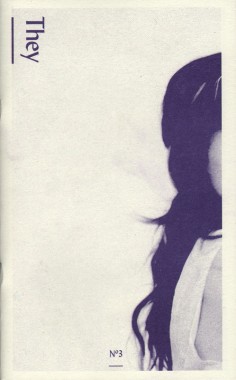
Azita Rasoli and Marshall Rake, They 3
Softcover, 40 pp., mimeograph 1/1, 130 x 210 mm
Edition of 100
Published by They Magazine
$10.00 ·
They Magazine is a dialogue between literature and art. Each issue has a unique design and features stories from different authors centered around one unifying thought.
They 3 features short stories from Dallas Clayton, Cian O’Day, Reeves Wiederman, Arna Bontemps Hemenway, Jason Parham and Aaron Lake Smith.
Aaron Lake Smith, Arna Bontemps Hemenway, Art, Azita Rasoli, Cian O'Day, Dallas Clayton, Design, Distribution, Fashion, Jason Parham, Literature, Marshall Rake, Reeves Wiederman, They
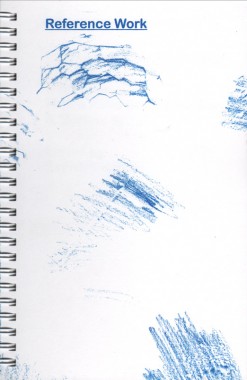
Martine Syms and Marco Kane Braunschweiler, Reference Work
Softcover, 98 pp., mimeograph 2/1, 5.5 x 8.5 inches
Edition of 250, numbered
Published by Golden Age and the Museum of Contemporary Art Chicago
$15.00 · out of stock
Reference Work is a conceptual business textbook.
As stated by Syms “Reference Work is the text I wish we had read prior to opening our business Golden Age. It contains original essays from Marco Kane Braunschweiler and I, the syllabus from the only business class we ever took, summaries from our favorite business books and a collection of resources that we’ve found helpful over the past four years. The book may be interpreted as sarcastic or irreverent, but I hope readers will notice our sincerity. It is difficult trying to enter the business world as a right brain thinker, not because those skills aren’t essential, but because that world is structured around hard metrics and art is difficult to quantify. Reference Work is intended to demystify some of the day-to-day operations of a cultural business and expand the definition of commercial success.”
The text was edited by Zachary Kaplan. The book was published with the assistance of the Museum of Contemporary Art Chicago on the occasion of We Are Here: Art & Design Out of Context, an exhibition curated by James Goggin.
Alfredo Ruiz, Art, Bob Brodsky, Culture, Design, Golden Age, James Goggin, Marco Kane Braunschweiler, Martine Syms, MCA, Museum of Contemporary Art Chicago, Scott Reinhard, Zachary Kaplan
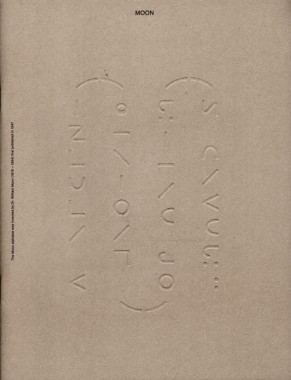
Jürg Lehni and Alex Rich, Research Notes
Softcover, 20 pp., offset 1/1, 195 x 255 mm
Edition of 500
ISBN 978-3-905714-95-1
Published by Nieves
$14.00 ·
In an attempt to celebrate how we find ourselves doodling while on the phone, testing pens in stationery shops, our belief in folklore, the need to misuse technology or whose idea it was to fly aero planes in formation to write messages across our skies.
The research notes selected from the archive A Recent History of Writing & Drawing hopefully provide references to things old, new and maybe forgotten which together can offer an alternative understanding of our habit to document thoughts and ideas. Upending assumptions that any one kind of communication is more authentic, more direct or more valid that any other, A Recent History of Writing & Drawing finds meaning, texture and poetry in the most unlikely places.
Alex Rich, Art, Culture, Design, Distribution, Drawing, Jürg Lehni, Nieves, Science, Typography
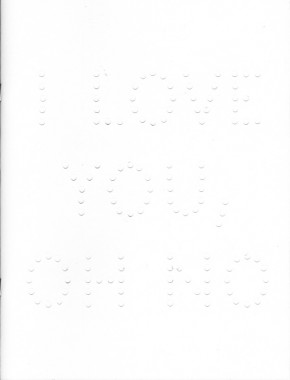
Jürg Lehni and Alex Rich, Empty Words
Softcover, 24 pp., cut paper, 195 x 255 mm
Edition of 500
ISBN 978-3-905714-93-7
Published by Nieves
$24.00 ·
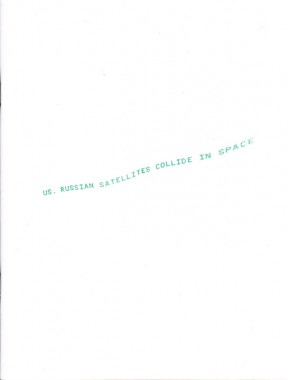
Jürg Lehni and Alex Rich, News
Softcover, 24 pp., offset 1/1, 195 x 255 mm
Edition of 500
ISBN 978-3-905714-94-4
Published by Nieves
$14.00 ·
The
Speed-i-Jet, a mobile pen-printer manufactured by
Reiner (Germany), is a device built around an industrial inkjet cartridge / printing head. With its clumsy user interface and 30 character maximum capacity, this charming parasitical product prompted the discussion of possible uses for such a device. Together with the curatorial staff of the institution, daily news headlines were selected and transferred onto the devices. Holding and moving the device like a pen, visitors could experience the writing of texts to which the author is ambiguous.
The headlines were collected during Things to Say at Kunst Halle Sankt Gallen, Switzerland, 14 February — 12 April, 2009.
Alex Rich, Art, Design, Distribution, Jürg Lehni, Kunst Halle Sankt Gallen, Nieves, Typography
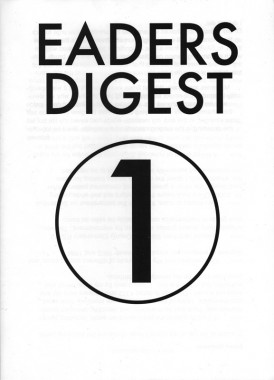
Eaders Digest 1
Softcover, 18 pp., offset 1/1, 140 x 200 [420 x 600 mm unfolded]
Edition of 1000
Published by Eaders Digest
$4.00 ·
Chemical Process: “It takes 1 cup wine 1/2 hr to reduce by 1/2 at 400 degs.”
Digestion started in 2009 as a set of experiments about metabolizing information. Eaders Digest currently takes the form of a publication.
In each issue, a six-stage metabolic reaction is begun. A previously published text is selected and sent to the first participant, who is asked to digest the text into another piece that must be a fixed number of words fewer than the original. The response can take any form within the word count constraint, borrowing from or transforming the source material. The digested text is sent to the next contributor with the same instructions. The word count shrinks weekly, until the final reduction phase is performed by the writer of the first seminal text.
Andrei Codrescu, Design, Distribution, Eaders Digest, Edvard Glücksman, Elvia Plyburn-Wilk, Kaye Cain-Nielsen, Niki Schur-Narula, Sheila Byers, William Zeytounlian
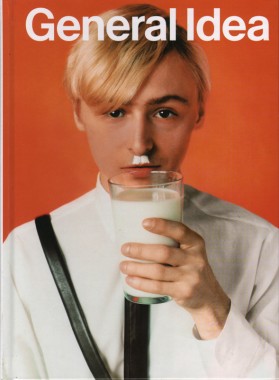
Frédéric Bonnet, General Idea: A Retrospective 1969-1994
Hardcover, 224 pp., offset 4/4, 174 x 238 mm
Edition of 2000
ISBN 978-3-03764-162-0
Published by JRP|Ringier
$40.00 · out of stock
This volume presents an overview of the Canadian collective oeuvre — an oeuvre still haunted by Miss General Idea, a fictive character who was at once muse and object, image and concept. Founded in Toronto in 1969 by Felix Partz, Jorge Zontal — both disappeared in 1994 — and AA Bronson, the trio adopted a generic identity that “freed it from the tyranny of individual genius.” Their complex intermingling of reality and fiction took the form of a transgressive and often parodic take on art and society. Treating the image as a virus infiltrating every aspect of the real world, General Idea set out to colonize it, modify its content and so come up with an alternative version of reality.
Paintings, installations, sculptures, photographs, videos, magazines, and TV programs: General Idea’s is an authentically multimedia oeuvre, that has lost nothing of its freshness and can now be seen as anticipating certain aspects of a current art scene undergoing radical transformation. The book covers the collective’s main areas of concern and themes, such as the artist and the creative process, glamour as a creative tool, art’s links with the media and mass culture, architecture and archaeology, sexuality and AIDS, etc. Including newly commissioned essays and republished texts, it is richly illustrated with documents and reproductions of the most important projects realized by General Idea from 1969 to 1994.
AA Bronson, Art, Clare Manchester, Clement Dirie, DAP, David Moos, Design, Elisabeth Lebovici, Felix Partz, Gavillet & Rust, General Idea, Jean-Christophe Ammann, Jorge Zontal, JRP|Ringier, Lionel Bovier, Louise Dompierre
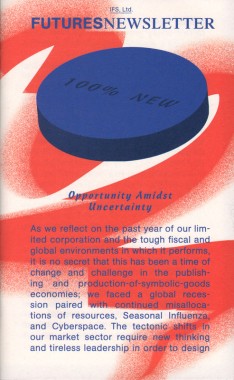
IFS, Ltd. Futures Newsletter, Opportunity Amidst Uncertainty
Softcover, 28 pp., offset 4/4, 110 x 175 mm
Edition of 6000
Published by IFS, Ltd. / Graphic Magazine
free* · out of stock
*free copy with each order
IFS, Ltd. Futures Newsletter is, in non-equal parts: a corporate bulletin, a speculative trading instrument, an experiment in memetic and symbiotic publishing, an internal-external analysis of company performance (B. Critton, H. Gassel, B. Griffiths, Z. Klauck, M. Nguyen), a proposal for an allegorical Escape Act (
S. Dockray), a bid for a series of six activities (
D. Horvitz), an abridged catalogue of semi-fictional gemstones (
L. Francescone), a profile of independent art book distributor (
Textfield, Inc.), and a self-reflexive / -reflective cartoon caption contest (
R. Rozendaal).
Investment Futures Strategy, Ltd. (United States) in partnership with GRAPHIC magazine (Korea) is pleased to introduce Futures, a semi-official newsletter published as a stand-alone supplement to GRAPHIC #17 (”When Design Becomes Attitude”). In lieu of a traditional contribution, IFS, Ltd. has chosen to use the GRAPHIC platform to continue its experiments in trade and publishing.
The Book Trust Prospectus examined new possibilities for funding, trade value, and distribution by attaching a different kind of significance to the object, thus short-circuiting the expected monetary transaction. Production of the Prospectus, however, relied on labor-intensive methods that required hours of input for a relatively small output. With the Futures newsletter, IFS, Ltd. has hybridized the positive aspects of large-scale corporate publishing — economies of scale or large print-runs, distribution of labor, and maximum efficiency — with the dictatorial authorship afforded by self-publishing. This new model maximizes potential as authors and designers while minimizing the opportunity cost of production and distribution.
Within the logic of IFS, Ltd. Futures will also act as a form of currency: readers can use their copy of the newsletter to trade for a copy of the Book Trust Prospectus. These recirculated copies of Futures will then be re-made available as a way to generate revenue for a future, freely distributed, as-yet-undefined project thus continuing the self-sustaining eco-system of publishing and distribution, one in which readers and producers collaborate to generate and circulate content outside of the cost-prohibitive channels of traditional publishing.
Art, Benjamin Critton, Brendan Griffiths, David Horvitz, Design, Distribution, Futures Newsletter, Graphic Magazine, Harry Gassel, IFS Ltd., Interview, Jonathan Maghen, Lauren Francescone, Lim Kyung Yong, Mylinh Nguyen, Na Kim, Nanette Sullano, Phil Chang, Rafael Rozendaal, Sean Dockray, Textfield, The Book Prospectus, Zak Klauck
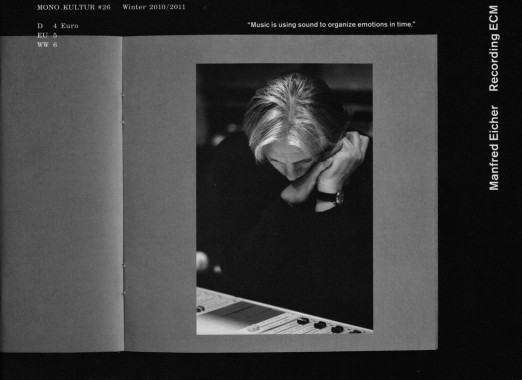
Mono.Kultur 26, Manfred Eicher — Recording ECM
Softcover, 42 pp., offset 1/1, 200 x 150 mm
Edition of 5000
ISSN 1861-7085
Published by Mono.Kultur
$9.00 · out of stock
Born in 1943 in southern Germany, Manfred Eicher dedicated his life early on to music, learning violin as a child, and studying double bass and classical music at the Academy in Berlin. On parallel tracks, he pursued an equally traditional self-education in jazz: through relatives in America, records bought in G.I. stores,
The Voice of America, listening to Bill Evans at the Village Vanguard, playing double bass in German jazz bands and with visiting musicians including Marion Brown, Leo Smith and Paul Bley.
In 1969, a meeting with the American jazz pianist and composer Mal Waldron led to Eicher’s first impromptu production and official release, Free at Last. The immediate success of the record beckoned for more, encouraging Eicher to move backstage and from then on to dedicate his life to finding and producing new music rather than performing. On the outskirts of Munich, with little financial backing, less strategy and no experience in production or managing a record label, Manfred Eicher launched ECM Records as a platform for jazz, a primarily American phenomenon on its wane.
Bernd Kuchenbeiser, Bill Evans, Caroline Heuer, Cheryl Koralik, Culture, Design, Distribution, ECM Records, Eva Gonçalves, Graphics, Joel Alas, Kai von Rabenau, Leo Smith, Manfred Eicher, Mareike Dittmer, Marion Brown, Mono.Kultur, Music, Paul Bley, Renko Heuer, Urs Bellermann
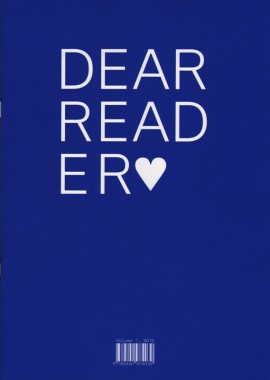
Dear Reader, Vol. 1
Softcover, 36 pp., offset 2/2 + spot varnish, 210 x 297 mm
Edition of 500
ISSN 2211-1085
ISBN 978-94-90974-03-9
Published by Carvalho Bernau
$13.00 · out of stock
A collection of obsessions, oblique references and footnotes of design processes — though not necessarily texts about design. The layout is appropriately diverse and eclectic for the bandwidth of texts, layering different formats and texts, as a tongue-in-cheek reference to the design shtick of publications with different paper formats. Here we present three iconic formats in emphasized-as-fake three-dimensionality, on four different papers and more inks than you would think.
Dear Reader was created partly from a primordial graphic designers’ urge to publish something and to share texts that are dear to us, partly in celebration of Atelier Carvalho Bernau’s approximate fifth anniversary, and partly as a vessel to showcase our type design work in a manner that circumvents the conventions and the visual clichés of the type specimen.
Adolf Loos, AG Fronzoni, Barbara Wright, Carvalho Bernau, Design, Distribution, El Lissitzky, Frederico Duarte, John Cage, Kai Bernau, Morton Feldman, Raymond Queneau, René Hague, Susana Carvalho, Typography
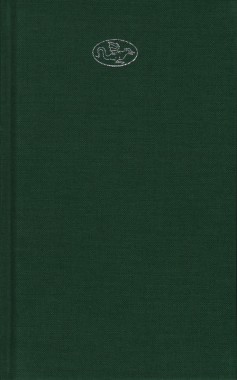
Garamond Press, False Friends
Hardcover, 48 pp., offset 1/1, 115 x 185 mm
English, French, and Dutch
Edition of 500
ISBN 0 978-94-90629-02-1
Published by Kunstverein
$18.00 ·
Antonio Pigafetta’s questionable travelogue from 1591, titled Regnum Congo, was based upon stories from Duarte Lopez, a Portuguese explorer who supposedly visited the Congo. The travelogue introduces an odd vision of European landscape in which fantastic creatures are presented. South-African artist Ruth Sacks re-contextualizes these historical interpretations by re-appropriating them into contemporary conditions, juxtaposing the varied characteristics. Hence the logo of her fictional publishing house, Garamond Press: a fantastic animal based upon a description of one of the possible animals from Regnum Congo. The narrative of the book False Friends derives from the storyline of Edgar Allen Poe’s Murders at the Rue Morgue from 1841, generally agreed to be the first detective story ever written. This contemporary version is set in Antwerp, Belgium, and is split into three languages: Dutch (Flemish), French and English. To follow the story’s plot, one has to be fluent in all three languages.
Anne Millar, Antonio Pigafetta, Art, Design, Distribution, Duarte Lopez, Edgar Allen Poe, Fiction, Garamond Press, Jaan Evart, Kunstverein, Marc Hollenstein, Ruth Sacks, Stephen Serrato
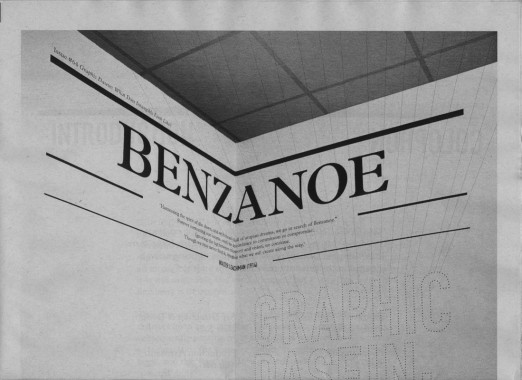
Benzanoe 64, Graphic Dasein*
Newspaper, 12 pp., web offset 1/1, 12.5 x 18 inches
Edition of 100
Published by Benzanoe
$8.00 ·
*
Dasein is the German vernacular term for
existence, it is derived from
da-sein, which literally means
being-there.
“The printed artifact always carries with it belief; under pinned by a historic and cultural relationship between print and truth. Issue 64 deals directly with this concept through a series of install tions, representing the pages of the magazine. The content is delivered through playing with perspective, perception, resolution, view point and production.“
Anders Ekblom, Bryan Clark, Design, Dion Star, Distribution, Dry Carolyn Shapiro, Lizzie Ridout, Martin Heidegger, Mat McIvor, Max Stirner, Steve Tanner, Walter Leachman
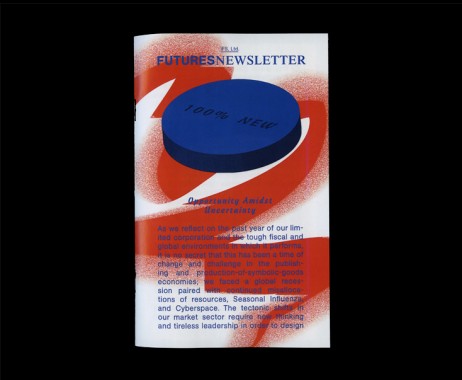
Investment Futures Strategy, Ltd. (United States) in partnership with
GRAPHIC magazine (Korea) is pleased to introduce
Futures, a semi-official newsletter published as a stand-alone supplement to GRAPHIC #17 (”When Design Becomes Attitude”). In lieu of a traditional contribution, IFS, Ltd. has chosen to use the GRAPHIC platform to continue its experiments in trade and publishing.
The Book Trust Prospectus examined new possibilities for funding, trade value, and distribution by attaching a different kind of significance to the object, thus short-circuiting the expected monetary transaction. Production of the Prospectus, however, relied on labor-intensive methods that required hours of input for a relatively small output. With the Futures newsletter, IFS, Ltd. has hybridized the positive aspects of large-scale corporate publishing — economies of scale or large print-runs, distribution of labor, and maximum efficiency — with the dictatorial authorship afforded by self-publishing. This new model maximizes potential as authors and designers while minimizing the opportunity cost of production and distribution.
Within the logic of IFS, Ltd. Futures will also act as a form of currency: readers can use their copy of the newsletter to trade for a copy of the Book Trust Prospectus (see: the Prospectus, left). These recirculated copies of Futures will then be re-made available as a way to generate revenue for a future, freely distributed, as-yet-undefined project thus continuing the self-sustaining eco-system of publishing and distribution, one in which readers and producers collaborate to generate and circulate content outside of the cost-prohibitive channels of traditional publishing.
The IFS, Ltd. Futures Newsletter is, in non-equal parts: a corporate bulletin, a speculative trading instrument, an experiment in memetic and symbiotic publishing, an internal-external analysis of company performance (B. Critton, H. Gassel, B. Griffiths, Z. Klauck, M. Nguyen), a proposal for an allegorical Escape Act (S. Dockray), a bid for a series of six activities (D. Horvitz), an abridged catalogue of semi-fictional gemstones (L. Francescone), a profile of independent art book distributor (Textfield, Inc.), and a self-reflexive / -reflective cartoon caption contest (R. Rozendaal).
Benjamin Critton, Brendan Griffiths, David Horvitz, Design, Futures Newsletter, Graphic Magazine, Harry Gassel, IFS Ltd., Interview, Jonathan Maghen, Lauren Francescone, Lim Kyung Yong, Mylinh Nguyen, Na Kim, Nanette Sullano, Phil Chang, Rafael Rozendaal, Sean Dockray, Textfield, The Book Prospectus, Zak Klauck












